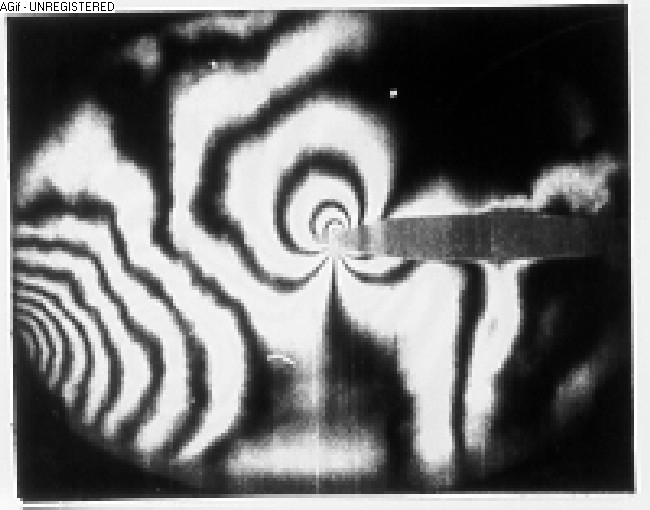My Projects
Topic: Aeroacoustics
Title: Flow Interaction of Vortices with Airfoils

The sequence of images is a slow motion visualization of an air current in a transonic wind tunnel
taken with a high-speed camera.
The flow is visualized by interference fringes based on the pressure drop
and the correlating lower density of the airflow.
At the lower half of the images, a circular vortex moves from right to left.
In the center of the images, the vortex strikes an airfoil.
The velocity of the airflow is about Mach 0.9 (i.e. 90% of sonic speed or ca. 300 m/s)
The original width of the image frame is about 30 cm.
The original duration of the whole sequence lasts about 1 millisecond.
What one doesn’t see:
The air vortices are generated on the left by the wake of a prismatic bluff body. The wake is stretched by a narrowing of the duct’s height. Thereby, the vortices get pulled apart from each other and become isolated.
The stall of a vortex over the complete depth of the duct channel is induced by means of acoustic resonance. Thereby, a two-dimensional flow is achieved for observation.
The build-up of this sequence provides a vortex turning clockwise. Thereby, the blade tip velocity on the airfoil is increased.
What’s behind it:
The incoming vortex provokes a shift of the stagnation point from the tip end to the upper side of the airfoil. However, when the vortex is covered by the airfoil, the impact pressure is released again to the wing tip. This is why the extended high-pressure area above the airfoil propagates against the airflow to the left side – as if the vortex is partly reflected by the airfoil. In fact, the quasi-stationary pressure gradient of an eddy current is partly converted into a non-steady sound field. This is why one hears the aircraft noise although you may be outside of the wake turbulence.
Additionally, at transonic flow velocities, the vortex can cause a supersonic area beneath the airfoil, which finishes with an unsteady shock wave. Please, recognize the sharp shock wave, which occurs beneath the airfoil and expands circularly to the left – against the airflow – as soon as the vortex leaves to the right side.
What you can obtain from it:
Air turbulence is responsible for aircraft noise. Obviously, the mechanism is enhanced, when trailing vortices hit the surface of the airfoil. Therefore, modern airplanes and helicopters use a specially designed blade tip in order to prevent the vortices from impingement with the wing or rotor blade, respectively.
My related publications:
Sound Generation and Flow Interaction of Vortices with an Airfoil and a Flat Plate in Transonic Flow, Fluid Dynamics Research 3, 344-348 (1987)
Some Processes of Sound Generation in a Vortex-Airfoil System with Parallel Axes, Journal d’Acoustique 12, 23-26 (1989)